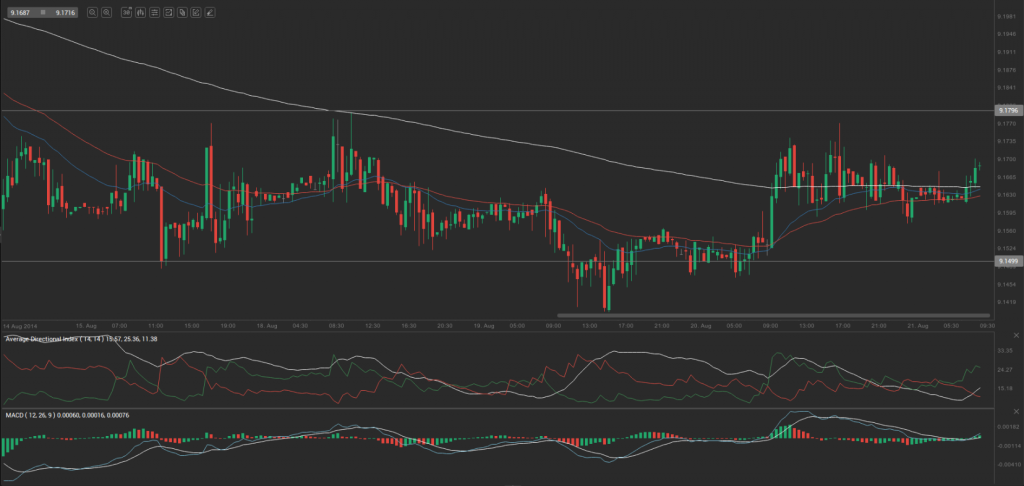Yesterday’s trade saw EUR/SEK within the range of 9.1489-9.1786. The pair closed at 9.1652, gaining 0.14% on a daily basis.
At 6:33 GMT today EUR/SEK was up 0.04% for the day to trade at 9.1709. The pair touched a daily high at 9.1718 at 6:20 GMT.
Fundamental view
Euro zone
Frances preliminary manufacturing PMI probably remained in the zone of contraction, coming in at 47.9 in August, acording to the median forecast by experts. The final PMI stood at 47.8 in July, as reported on August 1st. Values below the key level of 50.0 indicate that the majority of respondents in the survey expressed pessimism in regard to activity in the sector. Markit Economics is expected to release the official data at 7:00 GMT.
French preliminary services PMI probably slowed down to 50.3 in August from a final reading of 50.4 in the prior month. Values above 50.0 indicate optimism (expanding activity). Markit will publish the preliminary data at 7:00 GMT.
The preliminary reading of German manufacturing PMI probably dropped to 51.8 in August from a final reading of 52.4 in July, as reported on August 1st. The preliminary value is due out at 7:30 GMT.
Activity in German services sector probably slowed down in August, with the preliminary PMI falling to 55.5 from a final reading of 56.7 in July. The preliminary data is to be released at 7:30 GMT.
Manufacturing activity in the whole Euro region probably slowed down in August, with the preliminary Purchasing Managers Index slipping to 51.4 in August from 51.8 during the preceding month.
The preliminary services PMI in the Euro zone probably also lost ground in August, reaching a level of 53.6. In July the final reading of the index was reported to have been at 54.2. Markit will release the preliminary data at 8:00 GMT. The PMI is based on a monthly survey, encompassing a sample of business entities, which represents private sector conditions in terms of new orders, output, employment, prices etc. Higher than expected readings would provide support to the common currency.
Confidence among consumers in the Euro area probably worsened in August. The preliminary Economic Sentiment Indicator (ESI) probably slid to -9.0 in the current month from a final reading of -8.4 in July, as reported on July 30th. The ESI reflects the level of optimism, which consumers have about economic development. The survey is conducted by phone and includes 23 000 households in the Euro zone. The questions asked stress on current economic and financial situation, savings intention and also on expected developments regarding consumer price indexes, general economic situation and major purchases of durable goods. The indicator measures consumer confidence on a scale of -100 to +100. A reading of -100 suggests a lack of confidence, zero means neutrality and a reading of +100 indicates extreme levels of confidence. Higher confidence usually implies greater willingness to spend, including large-ticket purchases, while consumer spending is a key factor behind economic growth. Therefore, in case the ESI fell more than anticipated, this would mount selling pressure on the euro. The European Commission is expected to release the preliminary reading at 14:00 GMT.
Sweden
The rate of unemployment in Sweden probably fell to 7.4% during July, according to the median forecast by experts, after reaching as high as 9.2% in June. If so, it would be the lowest unemployment rate since December 2013. It represents the percentage of the eligible work force that is unemployed, but is actively seeking employment. The rate of unemployment also reflects overall economic state in the country, as there is a strong correlation between consumer spending levels and labor market conditions. Low rates of unemployment are accompanied by increased spending, which causes a favorable effect on corporate profits and also leads to overall growth acceleration. Therefore, in case the rate of unemployment fell more than expected, this would provide support to the krone. Statistics Sweden is to announce the official rate at 7:30 GMT.
Technical view
According to Binary Tribune’s daily analysis, the central pivot point for the pair is at 9.1642. In case EUR/SEK manages to breach the first resistance level at 9.1796, it will probably continue up to test 9.1939. In case the second key resistance is broken, the pair will probably attempt to advance to 9.2093.
If EUR/SEK manages to breach the first key support at 9.1499, it will probably continue to slide and test 9.1345. With this second key support broken, the movement to the downside will probably continue to 9.1202.
The mid-Pivot levels for today are as follows: M1 – 9.1274, M2 – 9.1422, M3 – 9.1571, M4 – 9.1719, M5 – 9.1868, M6 – 9.2016.
In weekly terms, the central pivot point is at 9.1697. The three key resistance levels are as follows: R1 – 9.1894, R2 – 9.2193, R3 – 9.2390. The three key support levels are: S1 – 9.1398, S2 – 9.1201, S3 – 9.0902.






